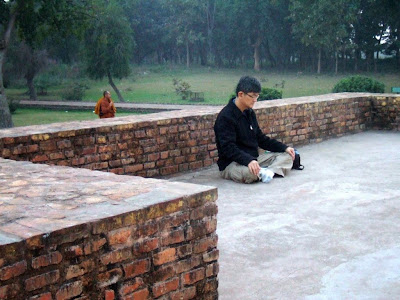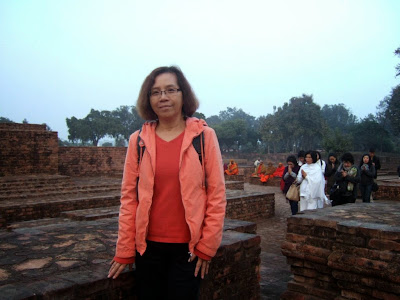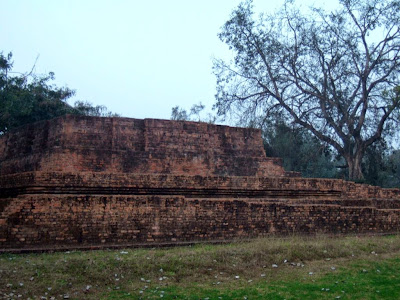
Sravasti, located on the banks of Rapti River in Uttar Pradesh State of India, was known as Sahet-Mahet locally. It was originally founded by King Sravast in Vedic Bharat period and had been an ancient capital to Kosala Kingdom during 6th BC to 6th century AD. The site was said to be the place where Buddha in response to six non-believers, performed twin miracles. The Lord manifested into multiple images of himself, and with fire and water emanated from body while seated on a 1000 petaled lotus flower. Buddha spent most of his monastic time and delivered large amount of discourses included a major part of Tripitaks at Sravasti. The 871 suttas in the 4 Nikayas and Mahayana's Amitaba Sutra were preached at the Temple of Jetavana, Pubbarama and some suburbs areas.


The whole garden of Jetavana had once been covered with gold coins. It was said that the wealthy merchant Anathapindika after inviting Buddha to come to Sravasti, was seeking a place to build a retreat center and resident for the Lord. He found a suitable grove but discovered that it belonged to Prince Jetakumara who refused to sell the land to him. The Prince said No to him even he could cover the whole place with gold coins. But the deal finally went through after several coordination. Jeta agreed to accept Anathapindika's term that the purchased price was equivalent to the amount of gold coins that spread over the whole grove. Carts and carts of gold coins were brought in and piece by piece, side by side, they were laid on the land. When Anathapindika found that the numbers of gold was insufficient to cover a small part near the gateway and ready to get in more, Prince Jeta requested to make this part as his offer to Buddha, because the merchant's earnestness had moved and inspired him. Prince Jeta supplied the timber wood for building the monastery and further spent all the purchase money he received from Anathapindika on the construction of gateway, which turned up to be the most imposing structure in the garden at that time.



The historical park of Jetavana Gardens is one of the four main sacred pilgrimage destinations to all Buddhists because out of the 25 rain-retreat of Buddha in Sravasti, he spent 19 in Jetavana Monastery (6 times in Pubbarama). The story of Arahat Kisagotami who was one of the 75 greatest nuns, was happened during one of Buddha's Wassa retreat period. Kisa belonged to lowest caste of people in ancient India but she married to a rich husband and had a lovely son. The son gained her a position in the family but he died. Kisa was so mad that she carried the boy's body in arms and went round to seek medicine to make him alive but of course in vain. She finally came to see The Buddha. The Lord told her that to rescue his son, he need a handful of mustard seed obtained from family with no one died. Kisa walked through town knocking house to house but just could not find a family of that condition. Kisa finally realized that death was part of the life and soon she left home. Through watching the candle flames, she observed the ups and downs of birth and death and attained Arahathood at last.


The Chinese pilgrim monk Xuanzang when visited Sravasti in 7th century, found that the city was in ruins and he recorded down sites of various buildings. Jetavana and Pubbarama were the two main monasteries.


The large structure of Temple No. 1 Anandakuti was situated at northern side of Jetavana Garden. The monastery was laid as per normal plan setting with a central courtyard surrounded by rows of cells with veranda in front. The shrine and mandapat (altar) was set in the middle of the courtyard.



Paying great homage to the site where Buddha spent his 24 rainy seasons during annual Vassa period.


Buddha's first visit to Sravasti was by invitation of Anathapindika who together with Visakha, Suppavasa and Kosala King Pasenadi were great lay supporters to Buddha. Jetavana Gardens with the original name as Jetavane Anathapindikassa Arama which means Jeta Grove Anathapindikassa Monastery, was built to offer to Buddha as a retreat center and resident by Anathapindika and Jetakumara.


The ruins of Buddha Huts Mula-gandhakuti and Anandakuti of Saheth were one of the most sacred sites to Buddhists as it was here where Lord Buddha stayed during his many visits to Jetavana Monastery.


Temple No. 2 is believed to stand on the spot of the original edifice called Gandhakuti which was built by Anathapindika when he laid Jetavana Monastery. It was said the original monastery had seven layers and was adorned with all kinds of canopies and offerings with lamps burning on from dusk to dawn. The vihara was destroyed by a fire caused by a rat carried away in its mouth a lamp wick. It was later restored into two storey brick building. Gandhakuti is the most ornamental of all buildings at site.


The remains of the shrine and assembly hall in front of Gandhakuti and its east entrance are the most outstanding parts of the ruins. The 2.85 meter square shaped shrine hall has a low brick platform along the rear wall, which was believed to be the pedestal of a large statue. It was believed that there was a sandal wood Buddha image enshrined in the original 7-storey monastery.


Chinese monk Rev.Faxian when visited the site at 4th century, only saw a two layers brick building and Rev. Xuanzang found the brick structure already in ruins in his visit during 7th century.



Another name for Gandhakuti was Fragrant Chamber as the monastery was piled up with bundles of fragrant flowers offered by the devotees, when Buddha stayed here.


The best way to make offerings to the remains of Buddha relief at an open area, was to paste the gold foils onto the image, as most of the Thai and Myanmar devotees did.



Experience the force of the site where Buddha lived 2600 years ago.


Majority of Pilgrims came from countries of South East Asia like Thailand, Myanmar, Singapore, Japan, South Korea and Malaysia.


The site of Jetavana Temple is the main destination to pilgrims and they usually do meditation and chanting at Gandhakuti Buddha Hut or Ananda Bodhi Tree.


Jetavana Gardens was the second monastery built and offered to Buddha. The first one was the Bamboo Grove in Rajgir.


The monks come and meditate in the morning and return in the evening.












Thai monk and devotees were circling round the site and we followed behind. The benefits of going round the stupa or temple are not only accumulate our merits but also to get away misfortunes and disasters that might happened to us anytime.


Namo Tassa Bhagavato Arahato sammasambuddhassa......Homage to him, The exalted one, The perfect one, The fully enlightened one!






The rear portion of Buddha's Hut Gandhakuti.



The ground of Gandhakuti like most parts in the grove was thickly covered with trees.



Buddhist devotees led by monk were chanting at the site where Buddha used to deliver discourses or gave lectures.


The teaching site was surrounded by monasteries with cells.


The remains that were pasted with gold foils was the spot where Buddha delivered numerous discourses.


This should be considered as the most sacred Hall of lectures.






View of Buddha's Dharma teaching site.


Large area in front of Gandhakuti Buddha's Hut was built with monasteries.


The monasteries either in oblong or square shape contained large numbers of cells with verandas running along in front.


The monks began to leave the garden site when sun began to set.




The two brick terraces in front of Temple No.3 were restored at the original promenade used by Buddha for walking meditation.



Temple No. 3 built by Anathapindika to the north of Bodhi Tree was one of the most holly edifices in the Garden. It was believed to be the original spot of Koshambakuti. Chinese Monk mentioned that he saw the large image of Bodhisattva from temple No. 3 dated back to first century enshrined in a brick temple in Sravasti.



The stupa of Sariputta and Moggalana, two great disciples of Buddha, were in Jetavana Grove and existed until the time of King Ashoka.





The Ananda Bodhi-tree planted by Anathapindika in fornt of the Gateway was a cutting from the tree in Sri Lanka, that self grown up by a sapling of its original tree from Bohdgaya. The cutting was brought back by Maha Mogallana.



Bodhi tree was an object of devotion for all pious laity in Jetavana Grove. It was planted after Anathapindika told Ananda that he wished to make a shrine as a tangible support for the worship and The Lord in response to this, said that monuments built basing on something that was related to Buddha was most appropriate for this moment. He said that it was not the time yet to build memorials for corporeal relics and symbol without any material objects was not too easy to follow. So out of the three visible supports and kinds of shrines, Obtained something that had been used or connected to Buddha was the most suitable.


Under the request of Ananda, Buddha spent a night sitting under the tree to bestow on it.



Several monasteries, stupas and shrines were built during Buddha's time but only few survived the vagarious of nature.



Stupa No. 5



Temple No. 19 was one the largest monastery where it had a shrine hall and well in the compound. It was believed that the monastery was first built in 6th century but restored 3 times on the same foundation in 10th to 12th century.









Very Valuable photos and information........
ReplyDeleteThanks.Beautiful photos.
ReplyDeleteThanks for posting a nice article.
ReplyDeleteSravasti Residency Hotels